|
Home
Irish culture and history
Nissan Huts (Demolition of H Blocks)
Oil on canvas
60cm x 60cm / 23.6 in x 23.6 in
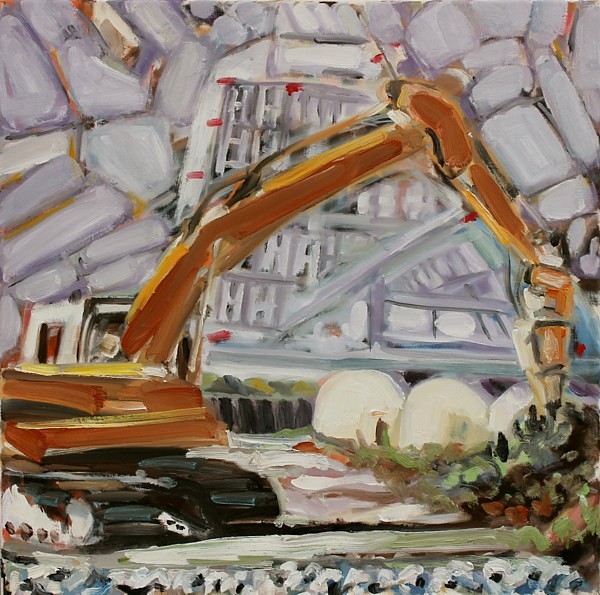
Notes
"Long Kesh / Maze
prison was infamous as the major holding centre for paramilitary
prisoners during the course of the Troubles in Northern Ireland. Some of
the major events of the recent conflict centred on, emanated from, and
were transformed by it, including the burning of the internment camp in
1974, the protests and hunger strikes of 1980-1981, the mass escape of
PIRA prisoners in 1983, and the role of prisoners in facilitating and
sustaining the peace process of the 1990s. Now, over a decade
after the signing of the Belfast Agreement (1998), Long Kesh / Maze
remains one of the most contentious remnants of the conflict and has
become central to debates about what we do with such sites, what they
mean, and how they relate to contemporary rememberings of the difficult
recent past."
An
Archaeology of the Troubles: The dark heritage of Long Kesh/Maze prison
Laura McAtackney (2014)
See:
http://ukcatalogue.oup.com/product/9780199673919.do
The Rise and Fall of James Connolly,
Beresford Place, Dublin.
Oil on canvas / Ola ar chanbhás
50cm x 60cm / 19.7 in x 23.6 in
Sold
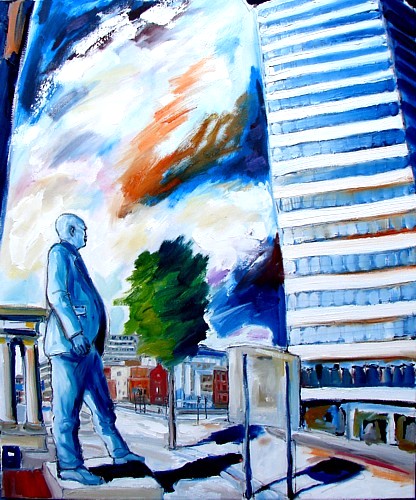
Notes
'In “The Rise and Fall of James Connolly”, the statue of Larkin’s
partner during the Dublin lock-out of 1913 stands outside Liberty Hall.
Today the building shelters the offices of the Services, Industrial and
Technical Union (SIPTU trade union) and until it was superseded by the
Elysian building in Cork in September 2008, the Liberty Hall building in
Dublin was the tallest storeyed building in Ireland. [...] In the years
leading up to the 1916 insurrection it harboured the Irish Transport and
General Workers Union when it was created in the early years of the 20th
century and the Irish Citizen Army (ICA). As in the other paintings, the
past is juxtaposed onto buildings of present-day Dublin creating a
city-space in which different moments of history collide. [...] The
plinth of Connolly’s statue is invisible and the statue almost seems
alive. Connolly himself seems suddenly overwhelmed and his arrogant
posture melts into a shadow onto the pavement, as the orange shape in
the sky, reminiscent of the fall of Icarus, hints at Connolly's failure
to fulfill his dreams.'
See: 'Post Celtic Tiger landscapes in Caoimhghin Ó Croidheáin's
paintings' by Marie Mianowski in
Post Celtic Tiger Ireland: Exploring New Cultural Spaces
Edited by Estelle Epinoux and Frank Healy (2016)
http://www.cambridgescholars.com/post-celtic-tiger-ireland
Bob Doyle (1916-2009) Commemoration
(The last Irish Brigadista)
O'Connell Street, Dublin
Oil on canvas / Ola ar chanbhás
50cm x 60cm / 19.7 in x 23.6 in
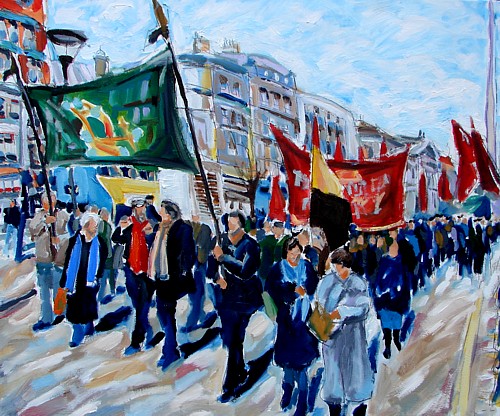
Notes
"Robert Andrew "Bob" Doyle (12 February 1916 – 22 January 2009) was a
communist activist and soldier from Ireland. He was active in two armed
conflicts; the Spanish Civil War as a member of the International
Brigades and the Second World War as a member of the British Empire's
Merchant Navy. [...] He initially attempted to travel to Spain by
stowing away aboard a boat bound for Valencia, where he was detained and
expelled. He eventually returned by crossing the Pyrenees from France.
After he returned to Spain, he reported to a battalion at Figueras. He
was initially required to train new recruits because of his IRA
experience, but disobeyed orders to get to the front. After fighting at
Belchite, he was captured at Gandesa by the Italian fascist Corpo Truppe
Volontarie in 1938, along with Irish International Brigade leader Frank
Ryan. He was imprisoned for 11 months in a concentration camp near
Burgos. There he was once brought out to be shot and he was regularly
tortured by Spanish fascist guards and interrogated by the Gestapo
before being released in a prisoner exchange."
See:
https://en.wikipedia.org/wiki/Bob_Doyle_(activist)
Great Famine Memorial,
Custom House Quay, Dublin.
Oil on canvas / Ola ar chanbhás
50cm x 60cm / 19.7
in x 23.6 in
Sold
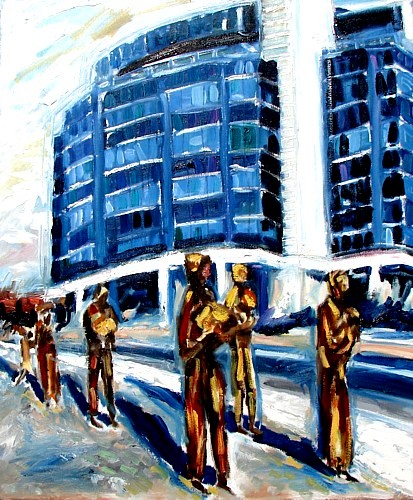
Notes
"Among them, Great Famine Memorial, Custom House Quay, Dublin (2007, 50
x 60 cm) depicts with accuracy the Bronze statues commemorating the
Great Irish Famine, mainly caused by potato blight, between 1845 and
1851. These sculptures were made by Rowan Gillespie and were placed in
1997 on The Customs House Quay, on the bank of the Liffey River, because
they were inspired by the following text: “A procession fraught with
most striking and most melancholy interest, wending its painful and
mournful way along the whole line of the river to where the beautiful
pile of the Custom House is distinguishable in the far distance”, a
quotation from The Irish Quarterly Review, dated 1854. [...] Another
allusion to Ireland’s riches corresponds to the function of the
buildings in the background of Great Famine Memorial. Indeed, the
largest can easily be recognised as the International Financial Services
Centre (IFSC), which is part and parcel of Dublin’s business district,
implemented by The Finance Act (1987) in order to attract foreign
companies with low taxation rates. This area, devoted to offices,
shopping facilities, restaurants and housing for businessmen and women
is highly criticised today, some accusing the government of allowing
companies to enjoy tax reductions whereas the rest of the country
suffers from austerity measures."
'Post Celtic Tiger Expressionism: Caoimhghin Ó Croidheáin’s Great
Famine Memorial, Custom House Quay, Dublin (2007)' by Amélie Dochy in
Post Celtic Tiger Ireland: Exploring New Cultural Spaces
Edited by Estelle Epinoux and Frank Healy (2016)
http://www.cambridgescholars.com/post-celtic-tiger-ireland
The colors in this painting have a high contrast between the whites of
the ground, bridge and sky and the shadows or dark windows as well as
the bright yellow-orange of the acid washed copper with that of the blue
in the building and the street. The vibrant contrast shows the true
dichotomy between the world these statues represent and the world they
live in today. The shape of the statues also draws the eyes of the
viewer up the painting almost as if they are arrows pointing to the
International Financial Services Centre (IFSC) in the background. This
piece shows an interesting perspective, instead of including the water
and the sky he instead chose to include the street and this building in
the background. Instead of painting what one might assume an artist
would paint, Ó Croidheáin is making an intentional statement by linking
these two Irish landmarks.
The IFSC is a representation of the low corporate tax rate that benefits
foreign companies establishing business here in Ireland while increasing
taxes for the Irish people. The sentiment behind connecting the starving
Irish ancestors with the IFSC reiterates that had it not been for the
priorities of an indifferent government the starving Irish of the 1800’s
could have died differently. The statues faces are not prominent in this
painting either. It is as if the faceless figures of the famine
represent the Irish people as a whole. Ó Croidheáin has taken the image
of Gillespie’s statues and used it to tell a different story. The idea
that history repeats itself is not a novel concept but one could
interpret that this painting is almost a word of warning,
reminding the viewer what a government indifferent to its citizens is
able to do. Instead seeing Ó Croidheáin’s work as a painting of
Gillespie’s statues, think of it instead as a painting inspired by the
statues, telling a different story with the same resources.
Casey Deal, 'The Great Hunger for Art', (7 Dec 2018)
Larkin's Despair,
O'Connell St, Dublin
Oil on canvas / Ola ar chanbhás
60cm x 80cm / 23.6 in x 31.5 in
Sold
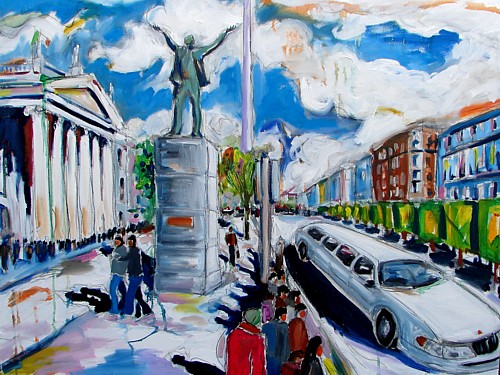
Notes
"The three colours of the Irish flag are repeated in most paintings as a
sort of background colour scheme, especially in ‘Larkin’s Despair’ where
the colours of the statue, the plinth and the inscription mirror those
of the Irish flag, although not in equal proportions. In ‘Larkin’s
Despair’ however, the irony appears through the exaggerations of the
painter: a huge white Limo stretches its arrogance along three blocks of
buildings as if to emphasize the grotesque exuberance of Celtic Tiger
wealth. Also the packed crowd of the 1923 photograph [of Larkin
speaking, upon which the sculpture is based], although less enthusiastic
than the 1913 one is reduced to nothing in the late Celtic Tiger period.
The streets are almost deserted with only a few people crossing
O’Connell street on both sides of Larkin’s statue but ignoring it.
Larkin is left all alone, with his arms stretched in despair and his
head down as if he were quietly sobbing."
See: 'Post Celtic Tiger landscapes in Caoimhghin Ó Croidheáin's
paintings' by Marie Mianowski in
Post Celtic Tiger Ireland: Exploring New Cultural Spaces
Edited by Estelle Epinoux and Frank Healy (2016)
http://www.cambridgescholars.com/post-celtic-tiger-ireland
The left hand side of the painting depicts the GPO [General Post
Office].
"During the Easter Rising of 1916, the GPO served as the headquarters of
the uprising's leaders. The building was destroyed by fire in the course
of the rebellion and not repaired until the Irish Free State government
took up the task some years later."
See:
https://en.wikipedia.org/wiki/General_Post_Office,_Dublin
"The famous photograph of James Larkin that inspired the monument [by
Dublin sculptor Oisín Kelly (1915–81)], was taken by Joe Cashman in
April 1923."
See:
http://www.historyireland.com/20th-century-contemporary-history/an-inspiration-to-all-who-gaze-upon-it/
The right hand side of the painting depicts a stretch limo, popular form
of celebratory transport used by working class people during the Celtic
Tiger years.
Larkin's Delight,
O'Connell St, Dublin
Oil on canvas / Ola ar chanbhás
60cm x 80cm / 23.6 in x 31.5 in
Sold
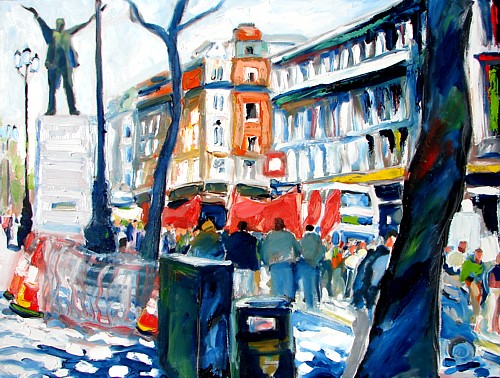
Notes
"By contrast in ‘Larkin’s
Delight’, the crowd is there, demonstrating and taking its destiny in
hands, claiming its own rights out on the street with Larkin’s statue
thrilled with delight."
See: 'Post Celtic Tiger
landscapes in Caoimhghin Ó Croidheáin's paintings' by Marie Mianowski in
Post Celtic Tiger Ireland: Exploring New Cultural Spaces
Edited by Estelle Epinoux and Frank Healy (2016)
http://www.cambridgescholars.com/post-celtic-tiger-ireland
Parnell's Providence,
O'Connell St, Dublin
Oil on canvas / Ola ar chanbhás
60cm x 80cm / 23.6 in x 31.5 in
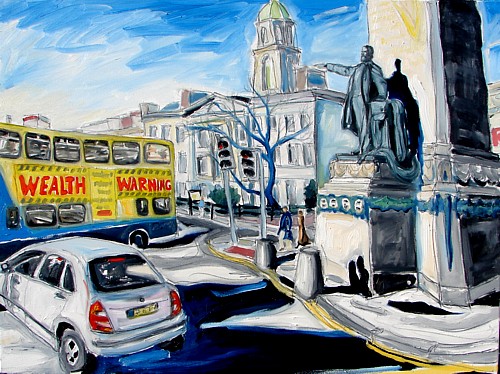
Notes
"Caoimhghin Ó
Croidheáin’s “Parnell” painting ironically shows Parnell’s statue
pointing at a passing bus on O’Connell street. On the painting,
Parnell’s stretched out hand points at a passing bus decorated with a
huge ad that reads: ‘wealth warning’. More explicitly than on the
others, the irony is blatantly visible on that painting where ‘wealth
warning’ replaces ‘health warning’ as if the statue had in turn become a
viewer of our contemporary world, revealing how, through landscapes, the
past continues to work in the present."
See: 'Post Celtic Tiger
landscapes in Caoimhghin Ó Croidheáin's paintings' by Marie Mianowski in
Post Celtic Tiger Ireland: Exploring New Cultural Spaces
Edited by Estelle Epinoux and Frank Healy (2016)
http://www.cambridgescholars.com/post-celtic-tiger-ireland
'Wealth Warning' was the tag line used in an advertising campaign by the
travel agency Budget Travel in the middle 2000s.
The statues of historical figures such as Jim
Larkin, Daniel O’Connell, Charles Stewart Parnell, and James Connolly
look down on a new city that sits uncomfortably with their varieties of
nationalism and socialism.
These
symbols of the past, standing in silent judgment of the follies of the
present, act as control rods in the current economic fission reminding
its old and new, wealthy and poor citizens alike of past struggles and
hardships.
'Young Ireland' vs Old Ireland,
College Green, Dublin
Oil on canvas / Ola ar chanbhás
60cm x 80cm / 23.6 in x 31.5 in
Sold
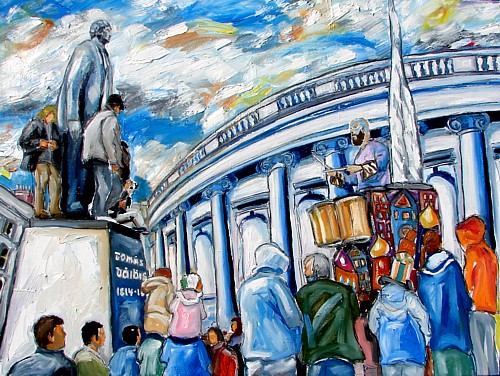
Notes
"In
the painting “Young Ireland vs Old Ireland”, the sculpture of Thomas
Davis’ silhouette is represented from a very low angle so that the
statue seems to be overlooking both the crowd and College Green. The
title of the painting echoes the “Young Ireland” movement to which
Davis’ belonged in the 1840s, a phrase coined in the first place as a
dismissive term by Daniel O’Connell to describe his inexperienced allies
in the Repeal Movement. Thomas Davis subsequently became the chief
leader of the Young Ireland movement and in the 1870s, the term came to
refer to the nationalists inspired by him.
The statue overlooks College Green as a tribute to Trinity College where
he was educated and to the University education he wished to promote for
Irish students of all backgrounds and confessions. [...]
In ‘Young Ireland vs Old Ireland’ the ironical contrast also stems from
a discrepancy between the past and the present. Davis’ statue outside
College Green is surrounded by a cheering crowd gathered there to watch
a Macnas parade. ‘Macnas are master storytellers who inspire and engage
audiences by creating big, bold, visual shows and performances through
world-class theatrical spectacle ’. On the painting a colourful drummer
advances, playing on exotic looking drums to an anonymous crowd of
hooded youths, and Davis’ famous ballad ‘A Nation once again ’ resonates
in the ears of the viewer of Caoimhghin Ó Croidheáin’s painting. As
Christie Fox points out, Macnas reinterprets folk tales through
contemporary issues, the priority being entertainment over education, a
choice that might have startled Davis whose preoccupation with education
was paramount."
See: 'Post Celtic Tiger
landscapes in Caoimhghin Ó Croidheáin's paintings' by Marie Mianowski in
Post Celtic Tiger Ireland: Exploring New Cultural Spaces
Edited by Estelle Epinoux and Frank Healy (2016)
http://www.cambridgescholars.com/post-celtic-tiger-ireland
Macnas (Irish for "Joyful Abandonment") incorporated Primitivism /
Tribalism in its artistic style, hence the reference to 'Old Ireland'.
O'Connell's Delight,
O'Connell St, Dublin
Oil on canvas / Ola ar chanbhás
80cm x 120cm / 31.5 in x 47.2 in
Sold

Notes
O'Connell's Delight refers to the wealth of the middle classes
symbolised by the profusion of SUVs [Sports Utility Vehicle] in Dublin.
O'Connell fought for the rights of the middle classes but was less
sympathetic to the rights of the working class:
"O 'Connell,
long revered in Irish history as 'The Liberator' was a consistent
enemy of the working class and laid the foundations for the anti
English and anti socialist premises at the root of much of Irish
nationalism. O Connell's family background is of interest as are
some of his less publicised political activities. O Connell was born
into a family of the minor landowning catholic gentry. He received
his education in France during the period of the French Revolution,
which swept away the reactionary catholic ancient regime forever.
These experiences are held as the formative influences on a
political career in which he famously declared the Irish freedom was
not worth the shedding of a drop of blood. It is a less well known
fact that O Connell was a volunteer with the Lawyers Yeomanry Corps
which rounded up supporters of Robert Emmet's failed rebellion in
1803, was the suppression of Irish freedom worth paying such a
price?"
"Against the Red Flag" Socialism and Irish Nationalism 1830 - 1913
Mags Glennon [See:
http://struggle.ws/cc1913/flag.html]
"O'Connell 'cherished a romantic attachment for his "darling little
Queen" (Victoria)' [p100] and when he took his seat as a supporter
of the Whig Government in the House of Commons 'voted against a
proposal to shorten the hours of child labour in factories' in 1838
[p104/5]."
[See P. Berresford, Ellis, A History of the Irish Working Class.
London, Victor Gollancz Ltd., 1972].
“There was no
tyranny equal to that which was exercised by the trade-unionists in
Dublin over their fellow labourers [O'Connell]."
in James Connolly Labour In Irish History
[See:
https://www.marxists.org/archive/connolly/1910/lih/chap12.htm]
Eoghan Rua O Neill (c1590-1649)
Oil on canvas / Ola ar chanbhás
50cm x 60cm

Notes
Owen Roe O'Neill (Irish: Eoghan Ruadh Ó Néill; c. 1585 – 6 November,
1649) was a seventeenth-century soldier and one of the most famous of
the O'Neill dynasty of Ulster in Ireland. O'Neill left Ireland at a
young age and spent most of his life as a mercenary in the Spanish Army
serving against the Dutch in Flanders during the Eighty Years' War.
Following the Irish Rebellion of 1641, O'Neill returned and took command
of the Ulster Army of the Irish Confederates. He enjoyed mixed fortunes
over the following years but won a decisive victory at the Battle of
Benburb in 1646. Large-scale campaigns to capture Dublin and Sligo were
both failures.
[See:
https://en.wikipedia.org/wiki/Owen_Roe_O%27Neill]
Wolfe Tone (1763-1798)
Oil on canvas / Ola ar chanbhás
60cm x 80cm
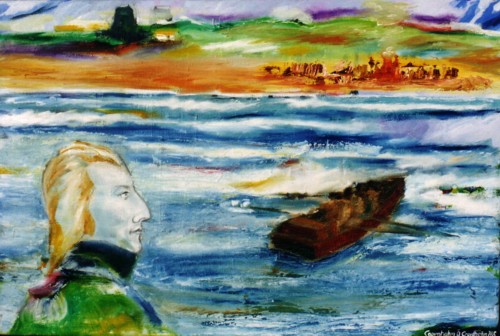
Notes
Theobald Wolfe Tone, posthumously known as Wolfe Tone (20 June 1763
– 19 November 1798), was a leading Irish revolutionary figure and one of
the founding members of the United Irishmen, and is regarded as the
father of Irish republicanism and leader of the 1798 Irish Rebellion. He
was captured at Letterkenny port on 3 November 1798.
See:
https://en.wikipedia.org/wiki/Wolfe_Tone]
Robert Emmet (1780-1803)
Oil on canvas / Ola ar chanbhás
50cm x 60cm
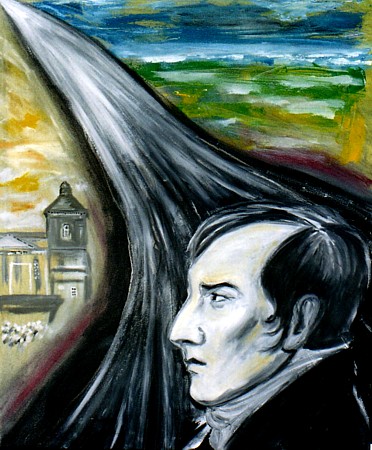
Notes
Robert Emmet (4 March 1778 – 20 September 1803) was an Irish
nationalist and Republican, orator and rebel leader. After leading an
abortive rebellion against British rule in 1803 he was captured then
tried and executed for high treason against the British king. He came
from a wealthy Anglo-Irish Protestant family who sympathised with Irish
Catholics and their lack of fair representation in Parliament. The Emmet
family also sympathised with the rebel colonists in the American
Revolution. While Emmet's efforts to rebel against British rule failed,
his actions and speech after his conviction inspired his compatriots.
[See:
https://en.wikipedia.org/wiki/Robert_Emmet]
John Mitchel (1815-1875)
Oil on canvas / Ola ar chanbhás
50cm x 60cm
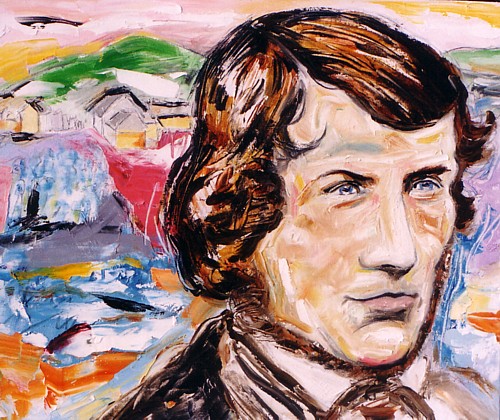
Notes
John Mitchel (Irish: Seán Mistéal; 3 November 1815 – 20 March 1875)
was an Irish nationalist activist, author, and political journalist.
Born in Camnish, near Dungiven, County Londonderry and reared in Newry,
he became a leading member of both Young Ireland and the Irish
Confederation. After moving to the United States in the 1850s, he became
a pro-slavery editorial voice. Mitchel supported the Confederate States
of America during the American Civil War, and two of his sons died
fighting for the Confederate cause. He was elected to the House of
Commons of the United Kingdom in 1875, but was disqualified because he
was a convicted felon. His Jail Journal is one of Irish nationalism's
most famous texts.
[See:
https://en.wikipedia.org/wiki/John_Mitchel]
Thomas Davis (1814-1845)
Oil on canvas / Ola ar chanbhás
50cm x 60cm
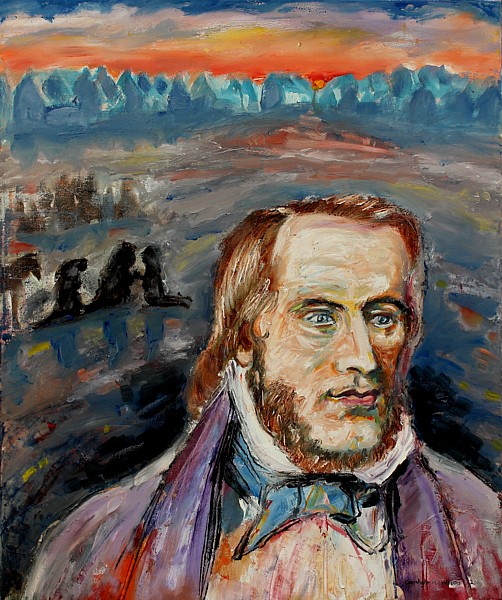
Notes
Thomas Osborne Davis (14 October 1814 – 16 September 1845) was an
Irish writer who was the chief organiser of the Young Ireland movement.
[...] Davis gave a voice to the 19th-century foundational culture of
modern Irish nationalism. Formerly it was based on the republicans of
the 1790s and on the Catholic emancipation movement of Daniel O'Connell
in the 1820s-30s, which had little in common with each other except for
independence from Britain; Davis aimed to create a common and more
inclusive base for the future. He established The Nation newspaper with
Charles Gavan Duffy and John Blake Dillon. He wrote some stirring
nationalistic ballads, originally contributed to The Nation and
afterwards republished as Spirit of the Nation, as well as a memoir of
Curran, the Irish lawyer and orator, prefixed to an edition of his
speeches, and a history of King James II's parliament of 1689; and he
had formed many literary plans which were unfinished by his early death.
He was a Protestant, but preached unity between Catholics and
Protestants. To Davis, it was not blood that made a person Irish, but
the willingness to be part of the Irish nation.
[See:
https://en.wikipedia.org/wiki/Thomas_Davis_(Young_Irelander)]
Charles Gavin Duffy (1816-1903)
Oil on canvas / Ola ar chanbhás
50cm x 80cm
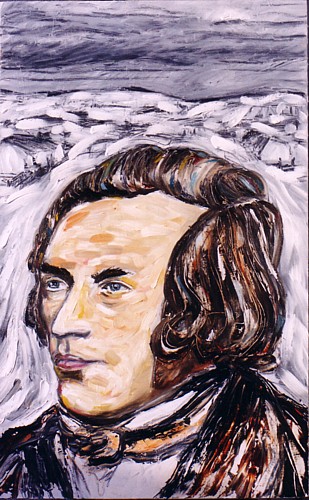
Notes
The Rt. Hon. Sir Charles Gavan Duffy, KCMG, PC (12 April 1816 – 9
February 1903), Irish nationalist, journalist, poet and Australian
politician, was the 8th Premier of Victoria and one of the most
colourful figures in Victorian political history. Gavan Duffy was one of
the founders of The Nation and became its first editor; the two others
were Thomas Osborne Davis, and John Blake Dillon, who would later become
Young Irelanders. All three were members of Daniel O'Connell's Repeal
Association. This paper, under Gavan Duffy, transformed from a literary
voice into a "rebellious organisation". As a result of The Nation's
support for Repeal, Gavan Duffy, as owner, was arrested and convicted of
seditious conspiracy in relation to the Monster Meeting planned for
Clontarf, just outside Dublin, but was released after an appeal to the
House of Lords. In August 1850, Gavan Duffy formed the Tenant Right
League to bring about reforms in the Irish land system and protect
tenants' rights, and in 1852 he was elected to the House of Commons for
New Ross.
[See:
https://en.wikipedia.org/wiki/Charles_Gavan_Duffy]
Michael Davitt (1846-1906)
Oil on canvas / Ola ar chanbhás
60cm x 90cm
Sold
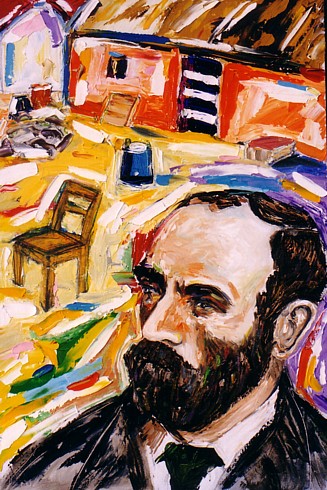
Notes
Michael Davitt (Irish: Mícheál Mac Dáibhéid; 25 March 1846 – 30 May
1906) was an Irish republican and agrarian campaigner who founded the
Irish National Land League. He was also a labour leader, Home Rule
politician and Member of Parliament (MP). [...] On 16 August 1879, the
Land League of Mayo was formally founded in Castlebar, with the active
support of Charles Stewart Parnell. On 21 October it was superseded by
the Irish National Land League. Parnell was made its president and
Davitt was one of its secretaries. This group united practically all the
different strands of land agitation and land movements since the Tenant
Right League of the 1850s under a single organisation, and from then
until 1882, the "Land War" in pursuance of the "Three Fs" (Fair Rent,
Fixity of Tenure and Free Sale) was fought in earnest. The League
organised resistance to evictions and reductions in rents, as well as
aiding the work of relief agencies. Landlords' attempts to evict tenants
led to violence, but the Land League denounced this. One of the actions
the Land League took during this period was the campaign of ostracism
against the land agent Captain Charles Boycott in Lough Mask House
outside Ballinrobe, Co Mayo, in the autumn of 1880. This campaign led to
Boycott abandoning Ireland in December and coined the word boycott,
which quickly spread across the world and through many languages.
[See:
https://en.wikipedia.org/wiki/Michael_Davitt]
Thomas Clarke (1857-1916)
Oil on canvas / Ola ar chanbhás
60cm x 70cm
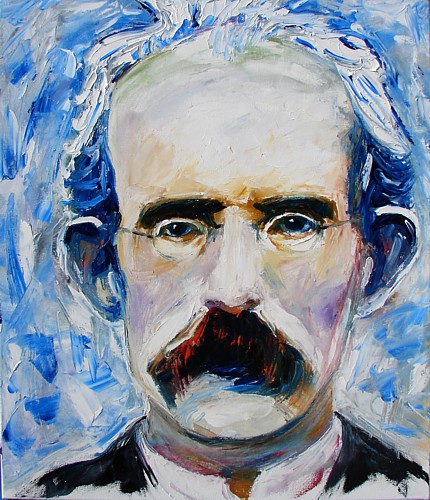
James Connolly (1868-1916)
Oil on canvas / Ola ar chanbhás
60cm x 70cm
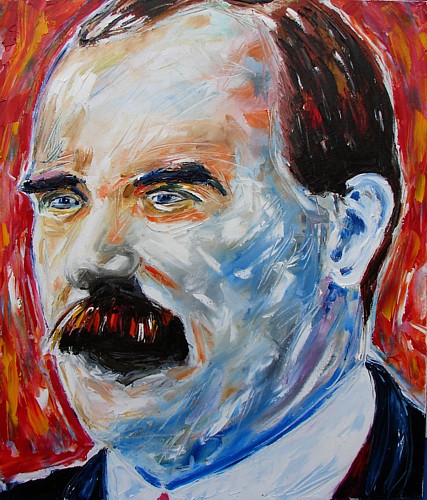
Patrick Pearse (1879-1916)
Oil on canvas / Ola ar chanbhás
60cm x 70cm

Eamonn Ceannt (1881-1916)
Oil on canvas / Ola ar chanbhás
60cm x 70cm
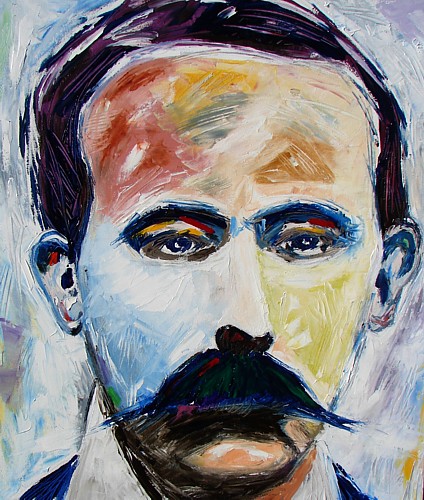
Sean Mac Diarmada (1884-1916)
Oil on canvas / Ola ar chanbhás
60cm x 70cm

Joseph Plunkett (1887-1916)
Oil on canvas / Ola ar chanbhás
60cm x 70cm
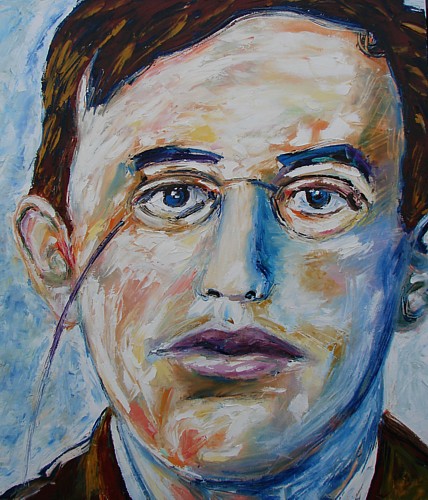
Thomas MacDonagh (1878-1916)
Oil on canvas / Ola ar chanbhás
60cm x 70cm
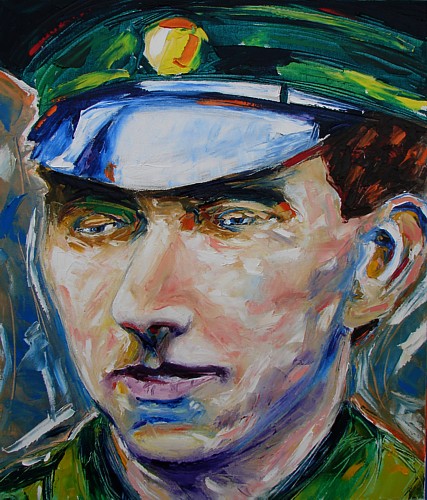
Countess Markiewicz (1868-1927)
Oil on canvas / Ola ar chanbhás
60cm x 70cm
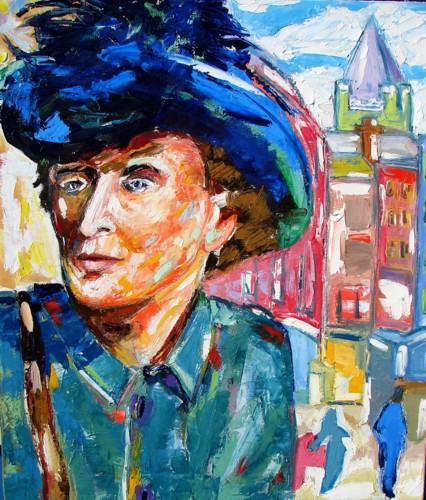
Roger Casement (1864-1916)
Oil on canvas / Ola ar chanbhás
60cm x 70cm
Sold
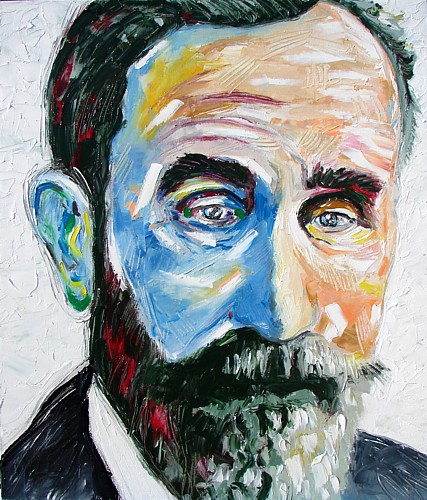
Frank Ryan (1902-1944)
Oil on canvas / Ola ar chanbhás
60cm x 90cm
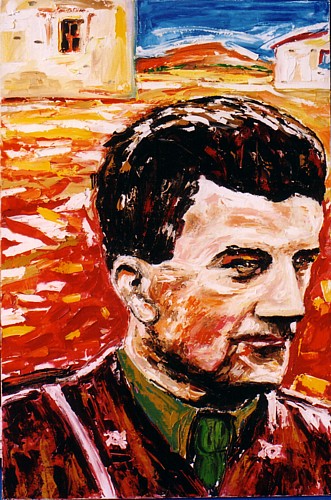
Máirtín Ó Cadhain
(1906 - 1970)
Acrylic and graphite on card / Aicrileach agus
grafít ar chárta
20cm x 30cm
Sold
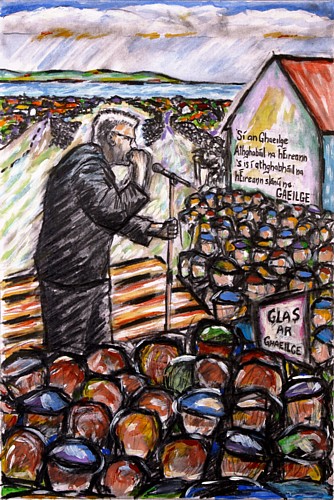
Scarecrow
Oil on canvas / Ola ar chanbhás
60cm x 90cm

Bloody Sunday 1972
Oil on canvas / Ola ar chanbhás
50cm x 60cm
Sold
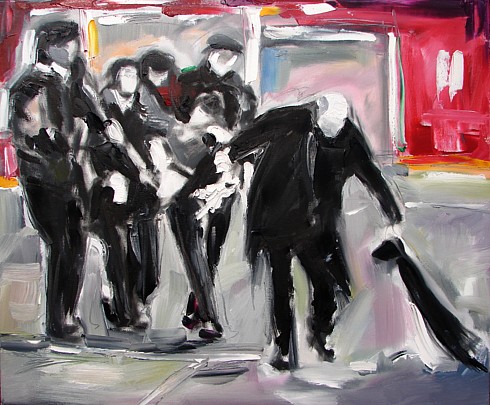
Hold the Rents
Oil and paper on canvas / Ola agus páipéir ar chanbhás-
50cm x 70cm
Sold
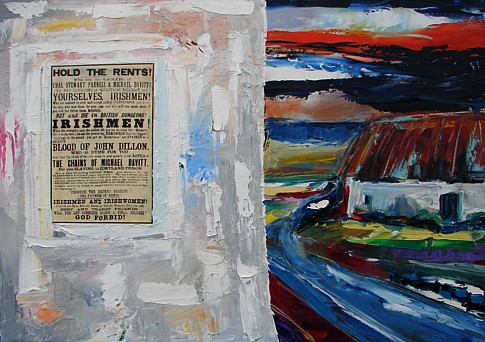
First Dáil,
Mansion House, Dublin, 1919
Oil on canvas / Ola ar chanbhás
50cm x 70cm
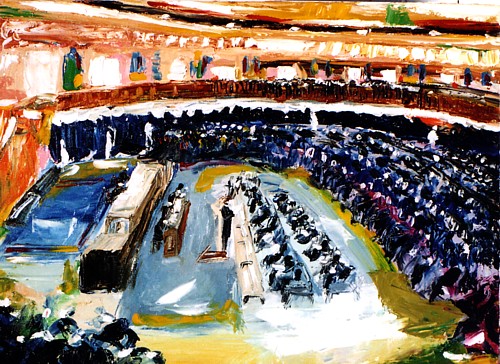
Set Dancing
Oil on canvas / Ola ar chanbhás
50cm x 70cm
Sold
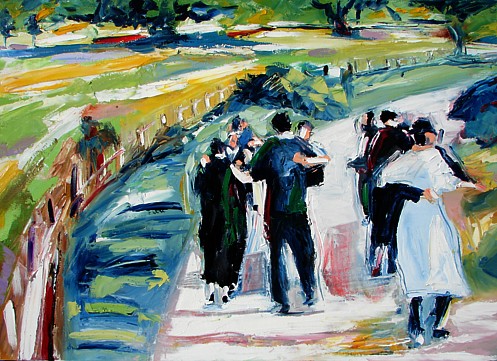
Second Dáil,
Mansion House, Dublin, 1921
Oil on canvas / Ola ar chanbhás
50cm x 60cm
Sold
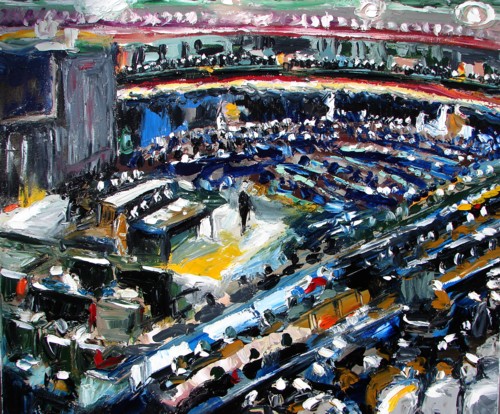
Allegory
(based on mid-fifteenth-century cadaver
tombstone, Beaulieu churchyard near Drogheda)
Oil on canvas / Ola ar chanbhás
40cm x 80cm
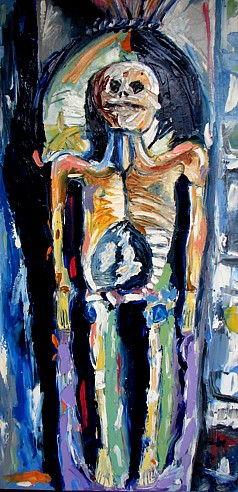
Bruree Workers' Soviet Mills, 1921
Acrylic on canvas / Aicrileach ar chanbhás
30cm x 80cm
Sold
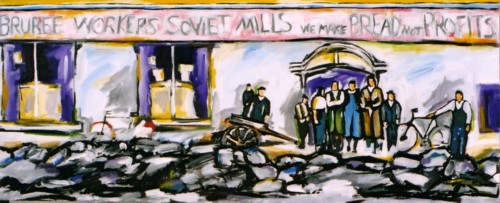
Gweedore, County
Donegal (19c)
Oil on canvas / Ola ar chanbhás
60cm x 80cm
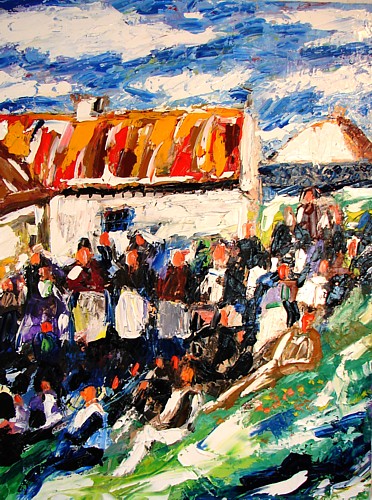
Citizens Army
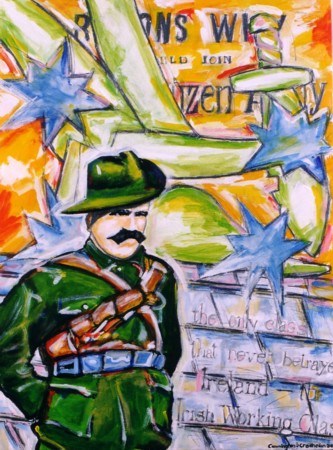
Pearse, Connolly, Larkin Triptych
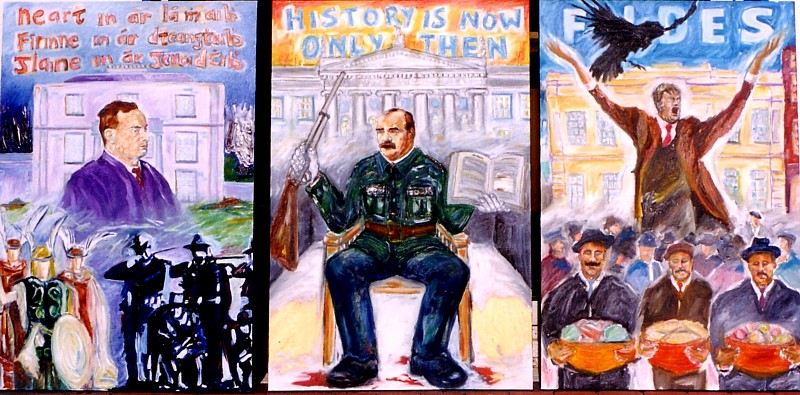
Home
|





































